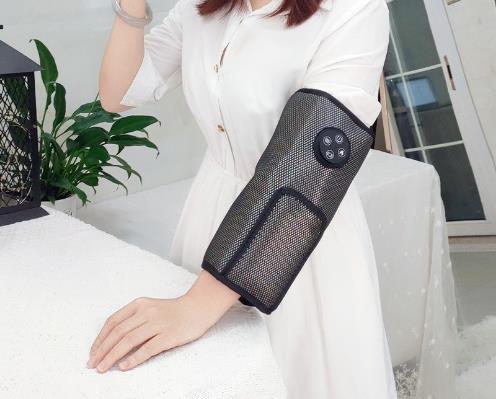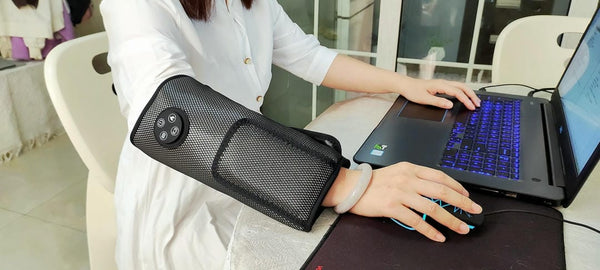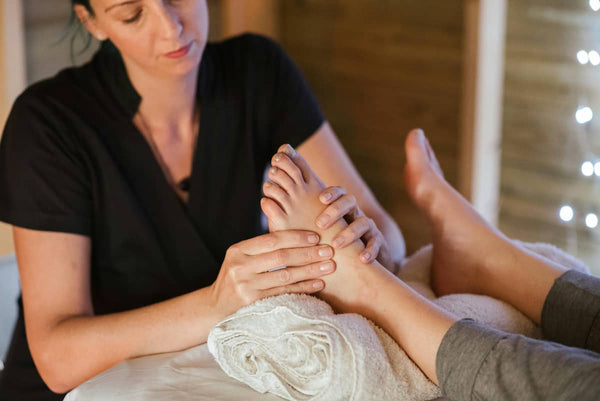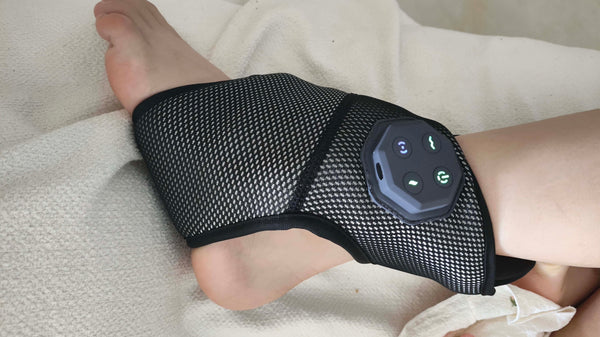
If you're an Aussie office worker, you know the drill. Long hours parked at a desk, battling deadlines and that endless stream of emails. But after a while, another battle begins—the one with that nagging, deep ache in your hips and backside. You stand up, and it’s stiff. You sit down, and it burns. It's a frustrating cycle that can put a real damper on everything from your productivity at work to enjoying a weekend barbie with mates. You’ve probably wondered, "Does massage help hip pain?" or maybe you've even typed "immediate sciatica pain relief" into Google in a moment of desperation. You're not alone, and the good news is, there are real solutions. Let's get this sorted and talk about whether a hip massager is just another gadget or a genuine tool for relief.
What's Causing That Nagging Pain in Your Hips and Buttocks?
Before we can fix the problem, we need to understand it. For many of us spending our days in an office chair, from Melbourne's CBD to a home office in the Perth suburbs, the culprit is often a combination of factors related to a sedentary lifestyle. It’s rarely just one thing.
- Prolonged Sitting: This is the big one. Sitting for hours on end shortens your hip flexor muscles at the front and weakens your gluteal muscles (your bum) at the back. This imbalance pulls on your pelvis and lower back, creating strain and pain.
- Piriformis Syndrome: This is a classic cause of "pain in the butt." The piriformis muscle is a small muscle located deep in the buttocks. When it gets tight or spasms, it can irritate the sciatic nerve, which runs right underneath it. This mimics the symptoms of true sciatica, causing pain, tingling, or numbness down the leg. This is a key reason people search for sciatica massage.
- Hip Bursitis: Wondering how to massage hip bursitis? First, know what it is. Bursae are small, fluid-filled sacs that cushion your bones and tendons. Repetitive pressure (like from a bad chair) can inflame the bursa on the outside of your hip, leading to sharp, localised pain.
- General Muscle Tightness: When your glutes aren't firing properly, other muscles have to pick up the slack, leading to trigger points—those nasty, tender knots—and widespread muscle ache. This is where learning how to relieve buttock muscle pain becomes crucial for daily comfort.
The Science Behind Massage for Hip Pain Relief
So, does getting a massage actually do anything? Absolutely. It’s not just about feeling good for an hour. Targeted massage, whether from a therapist or a quality device like a buttocks massager, works on a physiological level to bring about real change.
Here’s how a good massage for sciatica relief works its magic:
- Increases Blood Flow: Massage stimulates circulation, bringing fresh, oxygenated blood to tight, starved muscles. This helps flush out inflammatory by-products and delivers the nutrients needed for how to speed up muscle strain recovery.
- Releases Muscle Knots: A targeted buttock massager can apply direct, sustained pressure to trigger points. This helps the knotted muscle fibres to release, easing pain not just in the knot itself, but also in the areas where it refers pain (like down your leg). This is similar to what a hip flexor release tool aims to do.
- Calms the Nervous System: The pressure and rhythmic motion of a massage can help switch your nervous system from "fight or flight" mode to "rest and digest." This lowers stress hormones and reduces your overall perception of pain.
The Tapping Massager Dilemma: A Quick Fix or a Risky Bet?
Many people's first instinct is to grab a percussive or "tapping" massager. They're everywhere, and they seem powerful. The story of buying six of them because they keep breaking isn't uncommon. While they can provide some temporary relief by pummeling a muscle into submission, they come with a fair few problems, especially for chronic hip issues.
- Poor Durability: As many users report, consumer-grade tapping massagers often aren't built for the kind of persistent use needed for chronic pain. They can break down quickly, becoming a frustrating and expensive habit.
- The "Too Much" Factor: High-end models like a Theragun are certainly more robust, but their power can be a double-edged sword. If you use them incorrectly, especially on an inflamed area like a bursa or directly on the sciatic nerve, you can aggravate the tissue and make the pain significantly worse. It’s not always a case of "more power is better."
- User-Friendliness: Let's be honest, trying to contort yourself to get the right angle on your own hip with a heavy, vibrating gun isn't easy for everyone, particularly for older Aussies or those with limited mobility.
A Smarter Approach: Choosing the Right Buttocks Massager for Chronic Pain
 Instead of a brute-force approach, the smarter path is to find a tool designed for the specific problem. This is where a specialised hip massager comes in. These devices are built differently, focusing on targeted pressure and adjustability rather than just aggressive percussion.
Instead of a brute-force approach, the smarter path is to find a tool designed for the specific problem. This is where a specialised hip massager comes in. These devices are built differently, focusing on targeted pressure and adjustability rather than just aggressive percussion.
For instance, some users have found great success with models like the KLCOSY hip massager. This type of device addresses the core issues of tapping massagers. It's designed to be more user-friendly with stronger adjustability. Its features often include different massage modes (not just one-note tapping), heat therapy to warm up muscles, and a more ergonomic design that allows you to apply consistent pressure without tiring yourself out. This makes it a more reliable tool for a long-term strategy of how to relieve buttock muscle pain. Plus, its versatility means you can often use it on other trouble spots like shoulders and knees – a real bonus.
How to Use a Hip Massager Effectively for Sciatica and Buttock Pain
Getting a great buttock massager is half the battle; using it correctly is the other half. Forget the idea of a miracle "one movement for instant sciatica pain relief"—real relief comes from consistent, intelligent application. Here’s a simple guide for your sciatica massage at home.
- Warm-Up: Never go in cold. Apply a heat pack or use the heat function on your hip massager for 5-10 minutes. This preps the muscles and makes them more receptive to the massage.
- Start Broadly: Begin with a gentle, broad pressure over the entire gluteal area. Spend a couple of minutes just getting the whole area used to the sensation.
- Hunt for Knots: Slowly move the massager around your buttocks, feeling for those tender, tight spots—your trigger points. The main culprit is often the piriformis, located deep in the centre of your buttock cheek.
- Apply Sustained Pressure: Once you find a knot, hold the pressure on it. Don't press so hard that you're wincing in agony. It should be a "good pain"—uncomfortable but bearable. Hold for 30-60 seconds, or until you feel the muscle start to release. Breathe deeply throughout.
- Avoid Bone and Nerves: Be careful not to press directly onto your hip bone (the bony bit on the side) or where you feel a sharp, shooting, electric pain, as that could be the sciatic nerve itself. You want to massage the muscle *around* the nerve.
This kind of targeted session is the most effective form of massage for sciatica pain you can do at home. For best results, aim for 10-15 minutes per side, a few times a week.
Frequently Asked Questions
How do you use a buttock massager for sciatica?
The key is to target the piriformis and gluteal muscles, not the sciatic nerve itself. Use sustained pressure on the tight, muscular parts of your buttocks to encourage them to release their grip on the nerve. Start gently, use heat first, and focus on deep, slow breathing as you hold pressure on tender spots.
Can a hip massager make bursitis worse?
Yes, it can. If you have acute, inflamed hip bursitis, applying direct, aggressive pressure or percussion can increase inflammation and pain. For bursitis, it's better to massage the surrounding muscles (glutes, TFL) to reduce overall tension, and use ice on the inflamed bursa itself. Always consult a health professional if you suspect bursitis.
What is the best type of massage for hip pain?
For chronic muscular hip and buttock pain, deep tissue or trigger point therapy is generally most effective. A quality hip massager or buttocks massager that allows you to apply sustained, targeted pressure is ideal for replicating this at home. This is often more beneficial than simple vibrational or tapping massage.
How often should I use a hip massager?
For chronic issues, consistency is key. Using your massager for 10-15 minutes per side, 3-4 times per week, is a great starting point. On days you feel particularly stiff, a gentle session can work wonders. Listen to your body—if you feel sore the next day, give it a day or two to recover before your next session.
This reply is generated based on currently verifiable public information. It is recommended to cross-check key content with authoritative sources. The information provided in this article is for educational purposes only and is not a substitute for professional medical advice, diagnosis, or treatment. Always seek the advice of your physician or other qualified health provider with any questions you may have regarding a medical condition.




0 comments